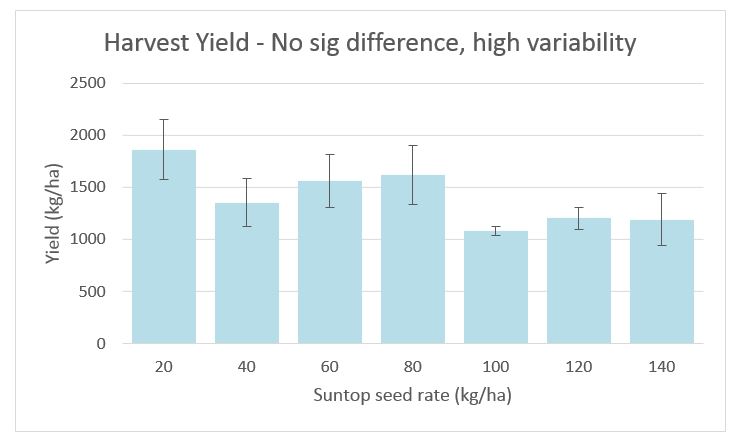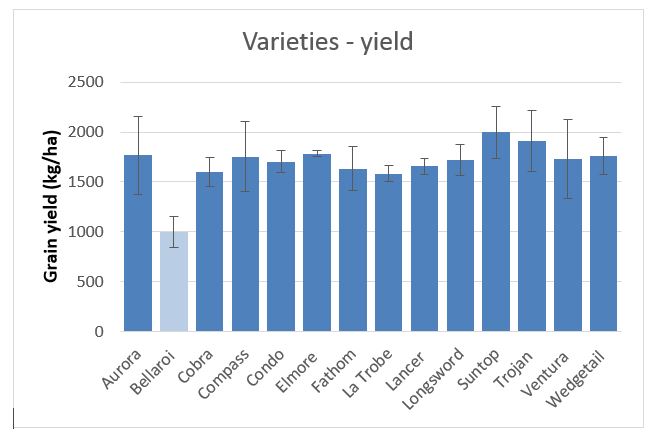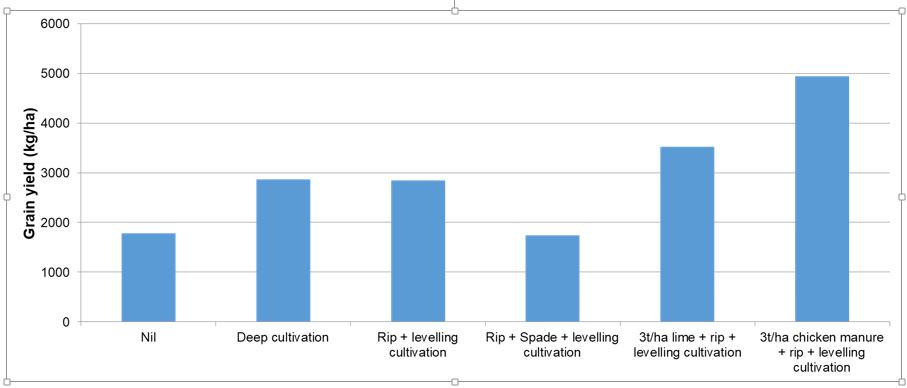Improving productivity on low fertility (sandy) soils
Improving productivity on low fertility (sandy) soils
Author: Barry Haskins, Rachael Whitworth (Ag Grow Agronomy and Research) Rai Kookana (CSIRO Land & Water) Lynne Macdonald (CSIRO Agriculture & Food). | Date: 13 Feb 2018
Take home messages
- Sandy soils represent a large part of the cropping region in South Western NSW, and have been traditionally poorer performing areas within the overall cropping program of most farms.
- With GRDC investment, recent research has shown the measured benefit of chicken manure, strategic cultivation/spading/ripping, choosing the right variety, increasing seeding rates and choosing herbicide strategies wisely.
- Herbicide carryover, in particular glyphosate and its metabolite; aminomethylphosphonic acid (AMPA) has been measured, and its effect on plant growth and subsequent grain yield on sandy soils needs further investigation.
- This paper presents the results from the first year of trials (2017). Trials will be conducted over three years (2017 to 2019).
Background
Sandy soils form a large part (>30%) of the cropping and grazing landscape across central and southern inland New South Wales (NSW), and parts of Victoria (VIC) and South Australia (SA). These soils often produce lower crop yields than other soils in surrounding areas and are acidic (pH CaCl2 4 to 5 in NSW mainly), highly erodible, carrying high in weed numbers and often accommodate limited root growth which causes soil moisture to remain after harvest.
Sandy soils are often characterised as containing >75% course textured sand and Cation Exchange Capacities (CEC) of <5mg/kg. They are therefore naturally low in fertility and store minimal plant available water (<60 to 80mm plant available water (PAW)).
The current research project (GRDC project number CSP00203) builds on previous research in the region on sandy soil types (GRDC project number AG00002, 2015). The current project aims to improve access to cost effective techniques to diagnose and ameliorate the primary constraints to poor crop water-use on sandy soils in the low to medium rainfall zone of the south-eastern region of Australia. The target sands for the project are primarily deeper sands where there is evidence of limited rooting depth and crop water extraction.
The key soil constraints to rooting depth and water extraction include physical and chemical impediments to root growth, nutrient supply and biological cycling, water repellence and poor establishment, and movement of water and nutrients beyond the rooting zone. Farming system constraints include effective broadleaf rotations, crop choice and varietal performance, erosion, disease and weed risks.
Research sites have been established at Griffith (NSW), Ouyen (VIC) and Lameroo (SA), as well as other sites in SA following on from the PIRSA New Horizons project. In addition, 10 sites were fully characterised taking intensive agronomic measurements which formed the basis of the foundation treatments for the project.
The Griffith site is characterised by high penetration resistance within 15cm depth, low soil pH, low organic matter, and low nutrient supply. Established in 2017, the current project is evaluating both mitigation (low cost, frequently applied) and amelioration (higher cost, profile improvement) approaches with the aim of increasing yield and profitability. These approaches include:
- Variety and seeding rate relationships on sandy soils.
- Strategic nutrition management.
- Effect of manure, lime and cultivation.
- Impact of herbicides and their residues on crop growth.
Variety and seeding rate relationships on sandy soils
Varietal performance on sands has been anecdotally known to be very different to performance on heavier soils. This has made choosing varieties difficult if a farm has a substantial area of sandy soils, as no variety trials exist on these soils. It is noted that varietal performance can sometimes be related to the variety’s acid soil tolerance, however this is not always the case. In addition, many growers have been increasing their seeding rates through variable rate applications with the aim of achieving better ground cover and higher yields on these fragile sandy soils.
A trial in 2015 (AG00002) demonstrated that varietal performance on sandy soils did not clearly relate to expected acid tolerance indicated from NVT trials on heavier soils. The data (Figure 1) demonstrated yields ranging from 1t/ha (Bellaroi) to > 4t/ha (La Trobe, Compass). Suntop (the regionally recommended variety) yielded approximately 3.4t/ha. Bolac, Spitfire, Gregory, Corack and Ventura all performed midrange (3.4 to 3.8t/ha). The trial also indicated good gains from increasing seeding rate, where yield from Suntop was improved by approximately 1.3t/haby increasing seeding rate from 40 to 150kg/ha. Lime made little or no difference to the varietal performance in 2015, the year of application.
The current GRDC project (CSP00203) provides an opportunity to build further on these results and to understand the potential yield gains over a wider range of seasons. The trials will monitor performance over multiple seasons (2017 to 2019) and calculate cumulative yield benefits. The first year of these trials (2017) was a much drier year (GSR 92mm), and suffered multiple frost events. Consequently, the same benefits in seeding rate were not demonstrated. Higher seeding rates (> 60kg/ha) caused the crop to hay off prematurely and there was no significant difference in yield between 20kg/ha and 140kg/ha seed (Figure 2). As per previous years, Bellaroi produced the lowest yields (approximately 1t/ha). However there was little difference between the yields (approximately 1.5t/ha; Figure 3) of the other varieties. Subsequent year trials’ results will be important in determining the performance of variety and seeding rate under a range of seasonal conditions.

Figure 1. Effect of variety, seeding rate and lime on grain yield, Griffith 2015.
Figure 2. Effect of seeding rate on grain yield in Suntop wheat, Griffith 2017.
Figure 3. Effect of variety choice on grain yield, Griffith 2017.
Strategic nutrition management
As a result of the inherent low nutrition status of sandy soils, application of various targeted nutrition strategies that increased yield, protein and gross margin were replicated from the previous project.
Results in both seasons were variable (Figure 4 and Figure 5), but in summary:
- Highest yields were in response to application of a minimum of 3t/ha chicken manure.
- Phosphorous (P) and nitrogen (N) were both important factors for producing high yields.
- During 2017, tissue testing for micronutrient imbalances followed by the application of foliar fertilisers (zinc (Zn), copper (Cu) and molybdenum (Mo)) to correct the imbalance did not increase yield.

Figure 4. Effect of specific nutrition strategies on grain yield, Griffith 2015.

Figure 5. Effect of specific nutrition strategies on grain yield, Griffith 2017.
Effect of chicken manure, lime and cultivation
Sandy soils typically have poor structure (high penetration resistance), low pH, and poor nutrient supply which all contribute to limited root exploration and crop water use. Amelioration approaches that look to address all three constraints included; deep cultivation or ripping, with/without lime or chicken litter amendments. A single season trial in 2015 demonstrated that deep cultivation or ripping could improve yield by approximately 1t/ha and that yield advantage could be maximised (>3t/ha)when ripping was combined with 3t/ha chicken litter (Figure 6).
A trial established in 2017, aims to better understand the multi-season impact of deep cultivation with/without chicken litter and lime (Figure 7). Results from the first year, indicate little gain from the physical intervention (deep cultivation or deep ripping) during the dry season. The greater yield gains (approximately 2.7t/ha) compared to the non-cultivated control were associated with higher N inputs (equivalent to about 200kg/ha urea) in either the non-cultivated, mineral fertiliser treatment (3.6t/ha) or the deep-cultivated, chicken litter treatment (4t/ha). The dry season likely limited any yield gains at the higher (>3t/ha) chicken litter application rates (Figure 7) due to haying off. Subsequent seasons’ results will be important in evaluating the economic benefits of more costly amelioration approaches.
Figure 6. Effect of manure, lime and cultivation on grain yield, Griffith 2015.

Figure 7. Effect of manure, lime and cultivation on grain yield, Griffith 2017. Note BP = Best practice, Tes = Trace elements, +N = Balanced N with 3t/ha chicken manure, CL = Chicken litter.
Impact of herbicides and their residues on crop growth
Crops grown on sandy soils can be prone to herbicide damage due to the soil’s enhanced capabilities of leaching into the root-zone and low organic matter with corresponding poor biological activity, which slows herbicide break down.
In both years, the impact that various herbicides (knockdown and pre-emergent) had on crop growth and yield was tested, and also the impact of herbicide residues was monitored.
Additionally, the project assessed if the addition of 3t/ha of chicken manure aided in lessening the herbicide impact on the crop, through either enhanced breakdown of the herbicide or better crop health enabling the crop to grow through any negative herbicide effects.
In 2015, there were small yield (0.5t/ha) differences between various herbicide treatments. While the trial was replicated, the effect of herbicide treatments was not statistically analysed, and therefore, the significance of the differences cannot be determined.
In 2017 there were no grain yield differences between treatments, including the 3t/ha of chicken manure treatment.
Testing for herbicide residues
Growers and advisers have become concerned about the possible effects of herbicide residues on crops grown in sandy soils. It is thought that the issue may arise from long-term accumulation of herbicide residues and/or inadequate plant back times compared to label recommendations.
The GRDC Sandy Soils project (CSP00203) measured herbicide residues across nine sandy soil sites in the low to medium rainfall region across south eastern Australia. Sampling included 0cm to 10cm, 10cm to 20cm and 20cm to 30cm to understand where in the soil profile herbicides were accumulating. The herbicides tested were; glyphosate and its break-down product AMPA, trifluralin, prosulfocarb, 2,4-D, triclopyr, 2-methyl-4-chlorophenoxyacetic acid (MCPA) and three imidazolinones (imazapic, imazapyr and imazamox).
While no significant build-up of herbicide residues was measured, glyphosate and AMPA were detected at all sites. On average across the sites, there was 0.22kg of glyphosate/ha and nearly ten times that level of AMPA (2.1kg/ha). The two NSW sites that were sampled had lower than average levels (approximately 0.1kg/ha and 1.2kg/ha for glyphosate and AMPA, respectively). The combined glyphosate and AMPA load in these NSW soils represents approximately two typical applications of herbicide (0.6kg/ha); however levels need to be considered in light of variation in herbicide application timing, frequency and rates across the sites. Consistent with the wider (nine) sample set, the residue concentrations in these two sites declined with depth (Figure 8). Concentrations of APMA within a given layer may be higher than glyphosate because of differences with interaction with soil texture and/or chemistry. This difference suggests that while glyphosate is undergoing breakdown its metabolite compound, AMPA is accumulating in the soil profile. Finer level depth sampling could provide a more detailed picture of what the growing plant root is exposed to.

Figure 8. Measurement of glyphosate (initial band from y-axis) and AMPA (secondary band from y-axis) residues in two NSW sandy soils that were included in the wider project survey (2017). Concentration at which crop damage occurs has not been specified.
Both glyphosate and AMPA can have phytotoxic effects on sensitive plant species. Wheat is relatively tolerant to glyphosate, but legume crops (in particular, lupin and soybean) have been found to be more sensitive. Little is currently known about the toxicity of AMPA to various plant species. As noted earlier, AMPA concentrations in the sandy NSW soils were approximately ten times greater than that of glyphosate. Wider work is needed to understand the potential effects of herbicide residues in sandy soil systems that already offer challenges to plant growth and vigour.
Conclusion
Sandy soils have a range of underlying soil constraints that limit crop water use and productivity. Understanding how different management strategies contribute to overcoming these constraints is important in determining the best way to manage these soils. The results presented in this paper indicate that it is possible to increase yields on sandy soils by up to 300% (Figure 1). Management practices such as application of chicken manure, strategic cultivation/spading/ripping, variety choice and seeding rate, application of adequate N and P, and in some cases lime all contributed to yield increases. The economic return of these practices is dependent on the season and yield potential over subsequent years, and investigation to quantify the economic return of these practices is part of the longer term current project.
Understanding herbicide behaviour in sandy soils, and their interaction with plant growth alongside other soil constraints is becoming increasingly important. In particular, further investigations on the effect that residues of glyphosate and its metabolite AMPA have on plant growth and yield are required.
Acknowledgements
The research undertaken as part of this project is made possible by the significant contributions of growers through both trial cooperation and the support of the GRDC, the author would like to thank them for their continued support.
This work is funded under the GRDC project CSP00203; a collaboration between GRDC, the CSIRO, the University of South Australia, the SA state government through Primary Industries and Regions SA, Mallee Sustainable Farming Inc., and AgGrow Agronomy and Research P/L.
Contact details
Barry Haskins
barry@aggrowagronomy.com.au
@agrobaz
GRDC Project Code: AGG00002, CSP1606-008RMX,



